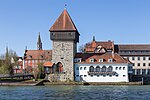Mainau

Mainau [ˈmaɪnaʊ] also referred to as Mav(e)no(w), Maienowe (in 1242), Maienow (in 1357), Maienau, Mainowe (in 1394) and Mainaw (in 1580) is an island in Lake Constance (on the Southern shore of the Überlinger See near the city of Konstanz, Baden-Württemberg, Germany). It is maintained as a garden island and a model of excellent environmental practices. Administratively, the island has been a part of Konstanz since December 1, 1971, when the municipality of Litzelstetten, of which Mainau was part, was incorporated into Konstanz. Mainau is still part of Litzelstetten, now one of 15 wards (administrative subdivisions) of Konstanz. The island belongs to the Lennart Bernadotte-Stiftung (eng. The Lennart Bernadotte Foundation), an entity created by Prince Lennart Bernadotte, Count of Wisborg, originally a Prince of Sweden and Duke of Småland. It is one of the main tourist attractions of Lake Constance. Beside flowers there is a park landscape with views on the lake. There is also a greenhouse with a tropical climate and thousands of butterflies. Mainau Bay is the location of their university's sailing club.
Excerpt from the Wikipedia article Mainau (License: CC BY-SA 3.0, Authors, Images).Mainau
Wein-Erlebnispfad, Verwaltungsgemeinschaft Konstanz
Geographical coordinates (GPS) Address Nearby Places Show on map
Geographical coordinates (GPS)
| Latitude | Longitude |
|---|---|
| N 47.705555555556 ° | E 9.1944444444444 ° |
Address
Wein-Erlebnispfad
78465 Verwaltungsgemeinschaft Konstanz, Konstanz-Litzelstetten
Baden-Württemberg, Germany
Open on Google Maps









